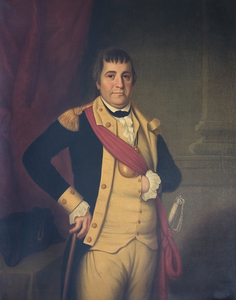
Barton, General William (1748-1831)
Role: Revolutionary War HeroDates: 1777
Portrait Location: Library-Annex 200
Artist: Lincoln, James Sullivan (1811-1888)
Portrait Date: 1857
Medium: Oil on canvas
Dimensions:
Framed Dimensions:
Brown Portrait Number: 8
Brown Historical Property Number: 1319
Serving with a Rhode Island regiment in the Revolutionary War, William Barton was an obscure colonel until he captured the British Major General Prescott in 1777. Barton was, allegedly, furious over the British occupation of Newport. When he learned from a British deserter that the major general was staying in a private residence five miles north of Newport, he stationed himself on Prudence Island with a telescope until he spotted the officer. On a moonless night and with a makeshift company of farmers and shopkeepers, Barton furtively paddled under the shadow of the British frigate Emerald and stole ashore. Without firing a shot, Barton took Prescott, who was wearing only a nightshirt, and fled with his prisoner, barely escaping gunfire from the Emerald. Barton's military service ended a year later when he was shot in the groin, but his fighting spirit did not. In 1812 he was in Vermont speculating on land that the government had recently made available when he was accused of profiting on the sale of lands he did not own. Protesting his innocence to the last, Barton was thrown into a jail cell in a local tavern where he remained for 13 years. In 1824 Marquis de Lafayette returned to the United States for a much-heralded tour and, when hearing of Barton's plight, immediately paid the $272 owed his accusers. Barton returned to his wife and sons in Providence, where he died six years later.
James Sullivan Lincoln's portrait of Barton is a copy based on an original by an unknown artist then in the possession of Barton's daughter, and now in the collection of the Rhode Island Historical Society. Originally from Taunton, Massachusetts, Lincoln apprenticed as an engraver in Providence from the age of fourteen, but turned to full-time painting in 1837. From that moment until his death, he reigned as Providence's premier portraitist. In his later years he often painted from photographs, producing portraits that are considered less strong than his earlier works. This work was presented to Brown by friends of the college in 1857, a time when John Russell Bartlett was putting together a hall commemorating Rhode Island heroes and was commissioning many copies of family portraits. This epoch was also marked by an intense interest in Revolutionary-era tales and memoralabilia.
